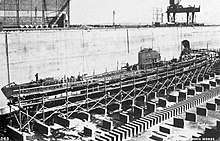French submarine Morse (1925)
The French submarine Morse was a Requin-class submarine built for the French Navy in the mid-1920s. Laid down in February 1923, it was launched in May 1925 and commissioned in February 1928. On 16 June 1940, Morse, under the command of Jean Georges Charles Paris, struck a mine and sank in the same minefield off the Kerkennah Islands that sank her sister ship Narval six months later.
 Morse in 1939 | |
| History | |
|---|---|
| Name: | Morse |
| Namesake: | walrus |
| Builder: | Arsenal de Cherbourg |
| Laid down: | 12 February 1923 |
| Launched: | 9 May 1925 |
| Commissioned: | 10 February 1928 |
| Fate: | Mined and sunk off Kerkenna on 16 June 1940. |
| General characteristics | |
| Class and type: | Requin-class submarine |
| Displacement: | |
| Length: | 78.30 m (256 ft 11 in) |
| Beam: | 6.84 m (22 ft 5 in) |
| Draught: | 5.10 m (16 ft 9 in) |
| Propulsion: |
|
| Speed: |
|
| Range: |
|
| Test depth: | 80 m (260 ft) |
| Complement: | 51 men |
| Armament: |
|
Design
Measuring 78 m (255 ft 11 in) long, with a beam of 6.8 m (22 ft 4 in) and a draught of 5.1 m (16 ft 9 in), Requin-class submarines could dive up to 80 m (260 ft). The submarine had a surfaced displacement of 1,150 tonnes (1,132 long tons) and a submerged displacement of 1,441 tonnes (1,418 long tons).

Propulsion while surfaced was provided by two 2,900 hp (2,163 kW) diesel motors and two 1,800 hp (1,342 kW) electric motors. The submarines' electrical propulsion allowed it to attain speeds of 9 knots (17 km/h; 10 mph) while submerged and 15 knots (28 km/h; 17 mph) on the surface. Their surfaced range was 7,700 nautical miles (14,300 km) at 9 knots (17 km/h), and 4,000 nautical miles (7,400 km) at 12 knots (22 km/h), with a submerged range of 70 nautical miles (130 km) at 5 knots (9.3 km/h).[2]
Service
From 1935 to 1937, Morse underwent a thorough overhaul. At the outbreak of World War II, she served in the Mediterranean Sea and was part of the 4th Submarine Flotilla in Bizerte. Morse's commander at the time was Captain J.G.C. Paris. In June 1940, Morse was still based in Bizerte. Morse blew up on a mine in the same minefield off the Kerkennah Islands that sank her sister ship Narval six months later.[3][4][5][6]
References
- "Requin Class French Submarines". battleships-cruisers.co. Retrieved 22 October 2018.
- "FR Morse of the French Navy - French submarine of the Requin class - Allied Warships of WWII". uboat.net. Retrieved 22 October 2018.
- "Batiments ayant porté le nom de Morse". www.netmarine.net.
- "Q 117". 4 March 2016. Archived from the original on 4 March 2016.
- Fontenoy, p. 182
Citations
- Fontenoy, Paul E. (2007). Submarines: An Illustrated History of Their Impact. ABC-CLIO. ISBN 9781851095636.